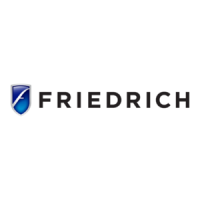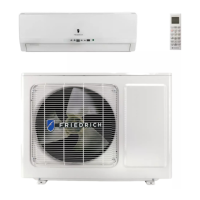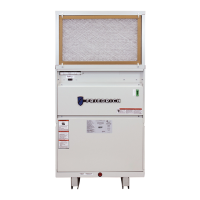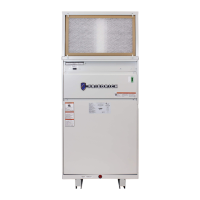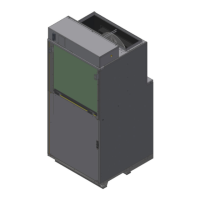70 PB
OPERATION
Control logic description
Communication between indoor and outdoor units:
The communication between the outdoor unit, thermostat and the indoor unit is achieved through 24 VAC. The thermostat controls the signal output
of Y and B, and the outdoor unit identifies its operation mode according to these two signals. If Y is 24v, the outdoor unit starts in cooling mode; if
both Y and B are 24v, the outdoor unit starts in heating mode. When the outdoor unit meets its defrosting conditions or anti‑cold air conditions in
heating mode, W is 24v, and when it exits from defrosting function and anti‑cold air function, W is 0v. SI signal is sent when outdoor unit runs in
low‑frequency mode.
Cooling Mode
Start conditions:
When 24v compressor signal (Y) and 0v 4‑way valve signal (B) are received from the thermostat the unit will start cooling.
Figure 401
Stop conditions:
When 0v compressor signal is received from the thermostat the unit will stop.
Actions:
The compressor keeps operating with its current frequency, and detects its system pressure at the same time.
(a) If the pressure changes more than 5.8 PSI (e2)in 10 seconds, the compressor stops operating.
(b) If the pressure changes less than 5.8 PSI (e2) in 10 seconds, the compressor keeps operating and the target pressure is set to increase by 2.9
PSI (e2) based on the current system pressure. The motor and electronic expansion valve are controlled as usual, the protection function and oil‑
return control are valid.
Stopping conditions:
When the compressor signal (Y) received from the thermostat is 24v and 4‑way valve signal (B) is low level, the unit restores the normal target
pressure to operate or when the compressor has operated for 30 minutes e2 with the increased target pressure, the unit will stop operation.
Compressor running rules:
When the unit starts up in cooling mode, the compressor starts to
work, and adjust its operating frequency according to the system target
pressure and the actual pressure. If the actual pressure is higher than
the target pressure, the compressor frequency will rise; if the actual
pressure is lower than the target pressure, the compressor frequency
decreases; when the target pressure is reached, the compressor
frequency will stabilize.
Outdoor fan running rules:
Once the outdoor fan starts up, it will follow the rules below:
Single outdoor fan: First, it will run in an invariable speed for a short
time; Then it will regulate the speed by the outdoor‑coil temperature.
Double outdoor fan: If it has two outdoor fans, the upper fan regulates
the speed by the rules, and the lower fan speed is slower than the upper
fan speed by 30rpm~60rpm.
Indoor Fan Running Rules
Unmatched system: Fan will operate according to fan setting on PCB.
Matched system: Fan will operate according to fan setting on PCB. RPM
may compensate for low‑load applications.
Thermostat
Indoor unit Outdoor unit
C
W
SI
W
C
B
Y
SI C
W B Y
Y: Compressor signal
B: 4-way valve signal
W: Defrosting signal
C: Common signal
SI: Low-frequency running singal
Figure 402
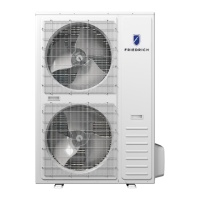
